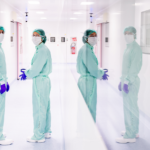
Polymeric and Lipid-based Nanosystems for CAR-T cell Delivery
Chimeric antigen receptor (CAR)-T cell therapy is a revolutionary method that has emerged as a cutting-edge cancer treatment, harnessing the patient’s T cells to bolster their immune system’s anti-cancer capabilities.[1] Traditionally, CAR-T cell production has relied on viral vectors, which present safety concerns, high costs, and production challenges. The investigation and development of alternative gene delivery systems are unlocking new possibilities. Non-viral systems, such as physical methods like electroporation and chemical approaches including nanoparticles, have emerged as alternatives. Nanosystems present a safer and more economical solution, although overcoming transfection hurdles in T cells requires innovative designs and engineering strategies. This article explores non-viral gene delivery platforms used for engineering CAR-T cells, emphasizing lipid and polymer-based nanosystems as a forefront technology.
Introduction
CAR-T cell therapy, an example of adoptive cellular immunotherapies, was approved[2] by the FDA and EMA to treat B cell malignancies and multiple myeloma. T lymphocytes typically identify and eliminate cells with foreign antigens, but cancer cells often elude this process. CAR-T cell therapy outfits T cells with artificial CAR receptors, enabling them to recognize and target cancer antigens, thereby redirecting their specificity and thwarting tumor evasion tactics. Advances in the field have resulted in increasingly sophisticated and effective CAR-T cell iterations. Most CAR-T cell therapies use gamma-retrovirus (γ-retrovirus) or lentivirus as gene delivery technology due to their high transduction efficiency. They can achieve stable gene expression through host genome integration, improving ex vivo genetic modification of T cells[3]. However, their inherent limitations have driven the exploration of physical and/or chemical non-viral gene delivery strategies for safer and more cost-effective gene delivery methods for T cell engineering.
The main non-viral alternatives are:
- Physical approach. Electroporation: applying external pulsed electric fields. Pulse delivery creates permeabilized areas in the cell membrane without affecting its viability, allowing impermeant molecules to enter. The main advantage is to afford transient gene expression. However, this process may lead to issues, such as: membrane disruption, cytotoxicity risk, loss of cytoplasmic content, altered expression profiles.
- Chemical approach. Nanosystems can be composed of various biomaterials, including inorganic materials, lipids, and/or polymers, and can be designed to achieve specific physicochemical properties such as size or surface functionalization. They can deliver various effector molecules like DNA or mRNA through endocytosis followed by endosomal escape, or through membrane-fusion events[4].
Currently, polymers and lipids are the most commonly used biomaterials in CAR-T cell development[5]. Polymer-based nanosystems offer easy surface modification and adaptable for both hydrophilic and hydrophobic cargo. Lipid carriers provide good biocompatibility, high bioavailability, and payload flexibility[6]. Despite potential liver and spleen toxicity and lower transfection efficiencies in lymphocytes compared to other technologies, these organic platforms are suitable for both in vivo and ex vivo applications. Their use in pre-clinical applications of CAR-T cell engineering has been successfully explored[7].
The different types of polymeric and lipid-based nanosystems are presented in the following sections.
Polymer-based nanosystem
Polymer-based nanoparticles used for gene delivery contain cationic polymers usually with repeating units containing amino groups (primary, secondary and/or tertiary). The positive charge of these groups establishes electrostatic interactions with the negative charge of the phosphate groups of the nucleic acid, leading to the formation of structures called “polyplexes”. Therefore, these platforms protect the genetic material from nucleolytic enzymes and, at the same time, allow for its efficient delivery and release into the target cells[8].
Several types of polycations architecture exist and are categorized depending on their composition and topology.
- The polymer composition (figure 1). The order of the repeating units represents the composition of polymers that include homopolymers and statistical, gradient, periodic, and block copolymers. While homopolymers contain only a single monomer, copolymers consist of at least two different types. Unlike the other copolymer types, block copolymers are constructed of at least two different block segments.

- Relative to the topology (figure 2) polymers can have linear, branched, graft, and star shapes.

The polymer architecture plays an important role in T cell-nanoparticle interaction, being the non-linear shape the most promising approach for CAR-T cell manufacturing .[9]
Another factor to consider in cationic polymers is their molecular weight (Mw). Polymers with higher Mw tend to form smaller polyplexes, enhancing transfection efficiency, but also elevating cytotoxicity compared to their lower Mw counterparts. This effect is linked to the higher number of positive charges in these polymers, which not only enhances nucleic acid condensation but also strengthens interaction with the cell membrane, particularly its negatively charged components. This increased interaction destabilizes the membrane, thereby inducing higher cytotoxicity.
Many cationic polymers were tested for gene delivery, but only a few of them were used for engineering T cells. Polyethylenimine (PEI), poly (2-dimethylaminoethyl methacrylate) (PDMAEMA), and poly(β-amino esters) (PβAE) are examples of synthetic polymers (figure 3) that have been studied for T cell transfection with success .[10]

Polyethylenimine (PEI) is a water-soluble, cationic polymer consisting of numerous ethyleneimine units. This non-biodegradable polymer has been effectively employed as a non-viral gene delivery system. Branched PEI (bPEI) and linear PEI (lPEI) are produced through the acid-catalyzed polymerization of aziridine and the ring-opening polymerization of 2-ethyl-2-oxazoline followed by hydrolysis, respectively. PEI, specifically bPEI with a molecular weight of 25,000 g/mol, has been considered as the gold standard for polymer-based cell transfection. Despite its advantages, such as low cost and ease of preparation and modification, PEI often exhibits high cytotoxicity, particularly at higher molecular weights[11].
Poly-(2-dimethylaminoethyl methacrylate) (PDMAEMA) has been studied because of its buffering capacity, reduced toxicity, and responsiveness to temperature and pH. The high capacity of PDMAEMA to complex the genetic material and its responsiveness to acidic environment allowed to obtain 51% of transfection efficiency in Jurkat cells.[12]
Poly-(β-amino esters) (PβAEs) are biodegradable water-soluble cationic polymers prepared by Michael addition of primary amine or bis (secondary amine) to diacrylate. This synthesis uses neat or anhydrous organic solvents to minimize hydrolytic degradation. The hydrolysis of backbone ester bonds allows it to get biodegradable and biocompatible properties. PβAEs have a vast monomer combination since they can be prepared with different acrylate and amine monomers, generating structurally diverse polymers. Moreover, PβAEs can have amine- or diacrylate-terminated chains depending on an excess of monomers used during synthesis[13].
Several synthetic polymers used in nanosystems formulation have been studied for delivering the CAR gene to T cells. Nevertheless, other cationic polymers that have not yet been explored in T cells but have the ability to transport and efficiently deliver genetic material, such as poly(l-lysine) (PLL), polyamidoamine (PAA) and poly(2-aminoethyl methacrylate hydrochloride) (PAMA), can also be considered as valid and promising approaches for the design of future non-viral gene delivery systems for T cell manufacturing.
Lipid-based nanosystem
The most attractive lipid-based formulations for nucleic acid delivery in CAR-T cells are liposomes and lipid nanoparticles (LNPs) that have different compositions, structures, and functions (figure 4).

Liposomes are formed mainly by one or more lipid bilayers of phospholipids surrounding an aqueous core, characterized by ease of preparation, minimal toxicity, and biodegradability. These nanocarriers can be prepared according to different methods, using amphiphilic molecules composed of hydrophobic tails and hydrophilic head groups. Their physicochemical properties, like size, charge, and membrane fluidity, can be easily modified by choosing the appropriate lipids and adjusting their ratio. These properties make liposomes, particularly the cationic ones, a potential platform for human CAR-T cell engineering.[14].
Cationic lipids are usually composed of a positively charged head group that binds to hydrophobic lipid anchor by a linker group. The head group can be categorized as follows: quaternary ammonium; primary, secondary or tertiary amines; guanidinium; heterocyclic; amino acids; and peptides.
Well-characterized cationic lipids for T cells transfection include dioctadecylamidoglycylspermine (DOGS) with a multivalent headgroup, N-[1-(2,3-dioleyloxy)propyl]-N,N,N-trimethylammonium chloride (DOTMA), DOTAP and β[N-(N′ , N′-dimethylaminoethane)-carbamoyl] cholesterol (DC-Chol), with monovalent headgroups (figure 5).
Different composition of these compounds affects the fluidity and lipid exchange of lipoplexes influencing the gene delivery efficiency. The linker group can also have a crucial role in biological activity and toxicity of lipoplexes, depending on the balance between its stability and biodegradability. For example, stable linker groups, like ether linkage (e.g. DOTMA), are more toxic than less stable ones, like ester linkage (e.g. DOTAP)[15]. This demonstrates that the transfection efficiency and toxicity of lipoplexes are dependent on the structure/composition of their cationic lipids.

On the other hand, DOPE, DOPC, and cholesterol (Chol) are examples of neutral lipids used in cationic liposome formulations (figure 6). They stabilize the lipid bilayer and can extend the blood circulation time of nanosystems[16].

Lipid nanoparticles (LNPs) contain a lipid layer surrounding micellar structures within the core and include ionizable lipids in their composition to allow the loading and complexation of nucleic acids. The general composition of these nanocarriers consists of different types of lipids (PEG)ylated, cationic, neutral, and ionizable lipids. Overall, the physicochemical and ionizable properties of LNPs allow for enhanced endosomal escape and potent nucleic acid intracellular delivery[17].
Other lipid systems, such as lipid nanoemulsions, solid lipid nanoparticles, and nanostructured lipid carriers, present a dissimilar structure and composition compared to the other two mentioned lipid nanoparticles and have been extensively studied for drug delivery but not for CAR-T cell engineering.
Conclusion and future perspectives
Polymer- and lipid-based nanosystems have demonstrated the ability to transfect T cells, resulting in safe and cost-effective genetic engineering of functional T cells when compared to other transfection/transduction technologies . With their continued optimization, such as physicochemical properties, encapsulation, release features, and surface modification characteristics, they can be used in clinical applications. These advances are improving the current T cell-based cancer treatments and are leading to the development of next-generation of T cell therapeutics.
Within a large expertise in polymer chemistry, including ring opening polymerizations (ROP), PEGylation, radical- and polycondensation, and synthetic lipid functionalization, the SEQENS group has several years of track record through process development to commercial manufacturing for customized GMP polymers and lipids.
By combining its expertise in polymer and lipid chemistry with the expertise of CELLforCURE by Seqens, dedicated to the GMP manufacturing of cell therapies, the SEQENS group uniquely brings together advanced material synthesis and cell therapy manufacturing under one roof.
CELLforCURE by Seqens, based near Paris, is a leader in the manufacturing of Advanced Therapy Medicinal Products (ATMPs), specialized in both autologous and allogeneic cell and gene therapy solutions. With over a decade of experience, CELLforCURE provides comprehensive end-to-end services, from early clinical phases to full-scale commercial production.
———————————————-
[1]A.K. Singh, J.P. McGuirk, CAR T cells: continuation in a revolution of immunotherapy, Lancet Oncol. 21 (2020) 168–178
[2]M.C. O’Leary et al. FDA approval summary: tisagenlecleucel for treatment of patients with relapsed or refractory B-cell precursor acute lymphoblastic leukemia, Clin. Cancer Res. 25 (2019) 1142–1146
[3]M. Sadelain, Chimeric antigen receptors: a paradigm shift in immunotherapy, Ann. Rev. Cancer Biol. 1 (2017) 447–466
[4]M.P. Stewart et al. In vitro and ex vivo strategies for intracellular delivery, Nature. 538 (2016) 183–192
[5]K.A. Hajj, K.A. Whitehead, Tools for translation: non-viral materials for therapeutic mRNA delivery, Nat. Rev. Mater. 2 (2017) 1–17[6]S. Simoes et al. Cationic liposomes for gene delivery, Exp. Opin. Drug Deliv. 2 (2005) 237–254
[6] S. Simoes et al. Cationic liposomes for gene delivery, Exp. Opin. Drug Deliv. 2 (2005) 237–254
[7]M.M. Billingsley et al. Ionizable lipid nanoparticle-mediated mRNA delivery for human CAR T cell engineering, Nano Lett. 20 (2020) 1578–1589
[8]B.R. Olden, Y. Cheng, J.L. Yu, S.H. Pun, Cationic polymers for non-viral gene delivery to human T cells, J. Control. Release 282 (2018) 140–147
[9]C.V. Synatschke et al. Influence of polymer architecture and molecular weight of poly(2-(dimethylamino)ethyl methacrylate) polycations on transfection efficiency and cell viability in gene delivery, Biomacromolecules. 12 (2011) 4247–4255
[10]D. Santo et al. Poly(ethylene glycol)-block-poly(2-aminoethyl methacrylate hydrochloride)-based polyplexes as serum-tolerant nanosystems for enhanced gene delivery, Mol. Pharm. 16 (2019) 2129–2141
[11]J. Lalani, A. Misra, Gene delivery using chemical methods, Chall Deliv. Ther. Genom. Proteom. (2011) 127–206
[12]A. Schallon et al. Nanoparticulate nonviral agent for the effective delivery of pDNA and siRNA to differentiated cells and primary human T lymphocytes, Biomacromolecules. 13 (2012) 3463–3474
[13]R.A. Cordeiro et al. Poly(β-amino ester)-based gene delivery systems: from discovery to therapeutic applications, J. Control. Release 310 (2019) 155–187
[14]E. Harris et al. Nonviral gene delivery to T cells with Lipofectamine LTX, Biotechnol. Bioeng. 118 (2021) 1674–1687
[15]G. Bozzuto, A. Molinari, Liposomes as nanomedical devices, Int. J. Nanomedicine 10 (2015) 975
[16]V.P. Torchilin, Recent advances with liposomes as pharmaceutical carriers, Nat. Rev. Drug Discov. 4 (2005) 145–160
[17]M.P. Lokugamage et al. Constrained nanoparticles deliver siRNA and sgRNA to T cells in vivo without targeting ligands, Adv. Mater. 31 (2019) 1902251
[18]IS. Pinto et al. Polymer- and lipid-based gene delivery technology for CAR T cell therapy, Journal of Controlled Release, Vol 353, 2023,196-215.




